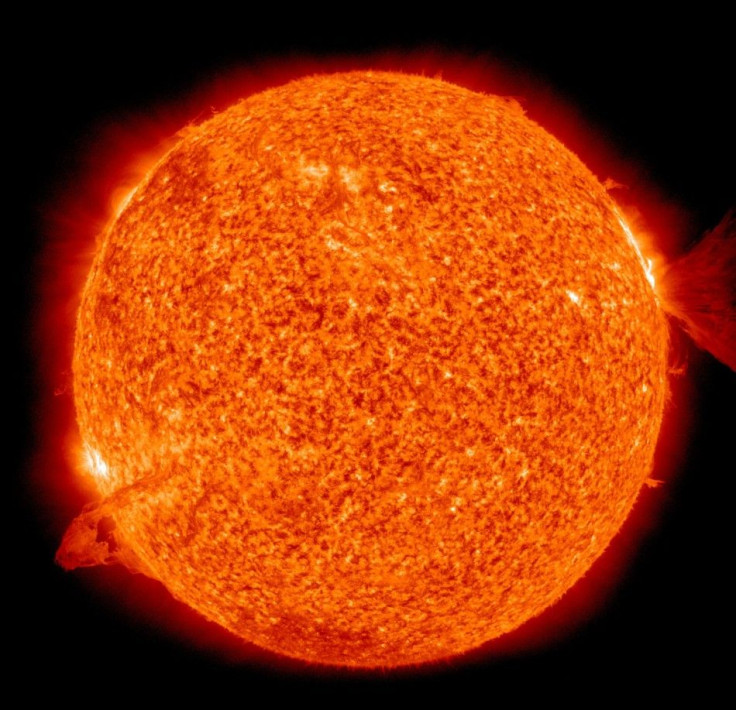Plasma Flow Linked to Spotless Sun

NASA explained the mystery behind the decreased solar activity during the Sun's 11-year cycle, linking it to the changing speeds of plasma inside the Sun.
The new computer model study suggests the Sun's plasma rivers speed up and slow down like a malfunctioning conveyor belt. The scientists identified that variations in a hot plasma flow in the sun's interior is the likely reason behind the lack of sunspots and a weak magnetic field at the sun's poles.
The Sun contains huge rivers of plasma similar to Earth's ocean currents. Those plasma rivers affect solar activity in ways we're just beginning to understand, said Andres Munoz-Jaramillo, a visiting research fellow at the Harvard-Smithsonian Center for Astrophysics.
All matter in the Sun is in the form of gas and plasma because of its high temperatures. The Sun is made of a fourth state of matter - plasma, in which negative electrons and positive ions flow freely. Flowing plasma creates magnetic fields, which lie at the core of solar activity like flares, eruptions, and sunspots.
The most recent solar minimum had an unusually long number of spotless days: 780 days during 2008-2010. In a typical solar minimum, the Sun goes spot-free for about 300 days, making the last minimum the longest since 1913.
Plasma currents deep inside the sun interfered with the formation of sunspots and prolonged solar minimum, said lead author Dibyendu Nandi of the Indian Institute of Science Education and Research in Kolkata. Our conclusions are based on a new computer model of the sun's interior.
The researchers believe they have developed a computer model that gets the physics right for all three aspects of this process -- the magnetic dynamo, the conveyor belt, and the buoyant evolution of sunspot magnetic fields.
According to our model, the trouble with sunspots actually began in back in the late 1990s during the upswing of Solar Cycle 23, said co-author Andres Munoz-Jaramillo of the Harvard-Smithsonian Center for Astrophysics. At that time, the conveyor belt sped up.
The sun's magnetic field weakened during the deep solar minimum, allowing cosmic rays to penetrate the solar system in record numbers, and making space a more dangerous place to travel. At the same time, Earth's upper atmosphere cooled and collapsed due to the decrease in ultraviolet radiation.
As a consequence space debris stopped decaying and started accumulating in Earth orbit due to increased atmospheric drag. These effects demonstrate the importance of understanding the entire solar cycle, during both minimum and maximum.
While Solar Max is relatively brief, lasting a few years punctuated by episodes of violent flaring, over and done in days, Solar Minimum can grind on for many years. The famous Maunder Minimum of the 17th century lasted 70 years and coincided with the deepest part of Europe's Little Ice Age. Researchers are still struggling to understand the connection.
In the 2000s, according to the model, the Conveyor Belt slowed down again, allowing magnetic fields to spend more time in the amplification zone, but the damage was already done. New sunspots were in short supply. Adding insult to injury, the slow moving belt did little to assist re-animated sunspots on their journey back to the surface, delaying the onset of Solar Cycle 24.
During long minima, strange things happen. In 2008-2009, the sun’s global magnetic field weakened and the solar wind subsided. Cosmic rays normally held at bay by the sun’s windy magnetism surged into the inner solar system.
During the deepest solar minimum in a century, ironically, space became a more dangerous place to travel. At the same time, the heating action of UV rays normally provided by sunspots was absent, so Earth’s upper atmosphere began to cool and collapse. Space junk stopped decaying as rapidly as usual and started accumulating in Earth orbit.
Nandi noted that their new computer model explained not only the absence of sunspots but also the sun’s weakened magnetic field in 08-09. It's confirmation that we’re on the right track.
NASA’s Solar Dynamics Observatory (SDO) can measure the motions of the sun’s conveyor belt -- not just on the surface but deep inside, too. The technique is called helioseismology; it reveals the sun’s interior in much the same way that an ultrasound works on a pregnant woman.
By plugging SDO’s high-quality data into the computer model, the researchers might be able to predict how future solar minima will unfold. Observations from SDO will eventually provide measurements that could validate the current model and provide the basis for future solar cycle prediction.
This research demonstrates how observations from Heliophysics System Observatory missions stimulate new theories and advance modeling techniques, said Richard Fisher, director of the Heliophysics Division in NASA's Science Mission Directorate at the agency's headquarters in Washington.
This research was funded by NASA's Living With a Star Program and the Department of Science and Technology of the Government of India. Results of the research will be in today's edition of Nature.
© Copyright IBTimes 2024. All rights reserved.





















